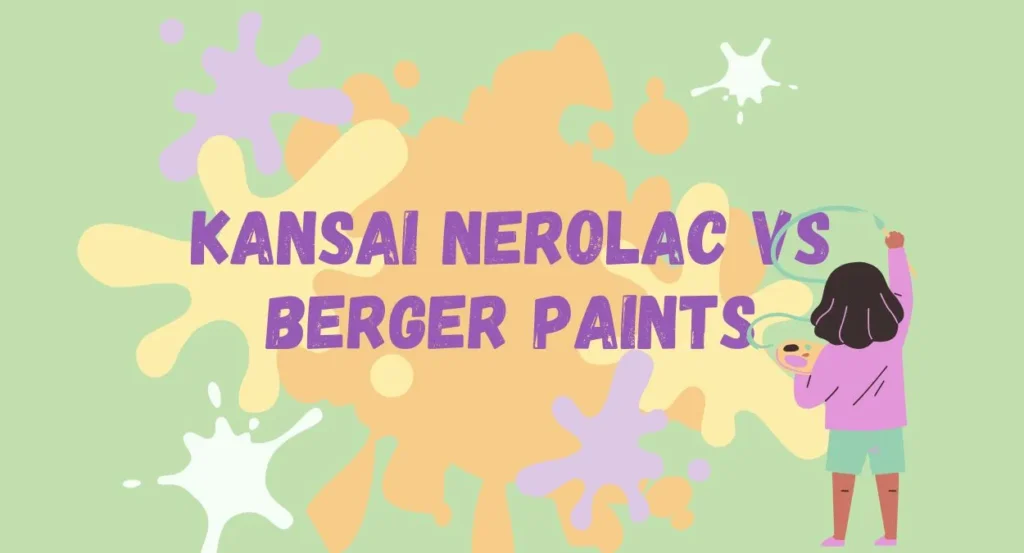The Indian paint industry is entering a defining phase, driven by increased infrastructure spending, rapid urbanization, rising disposable incomes, and greater awareness of aesthetics and sustainability. Two major contenders, Kansai Nerolac Paints and Berger Paints India, are not just competing for market share but also for a place in the portfolios of long-term investors. In this detailed comparison, we analyze both companies’ Q4 and FY25 performance, strategic direction, innovation capabilities, and growth outlook to determine which paint stock holds stronger potential for the long haul.

Financial Performance: Stability vs. Growth Acceleration
Kansai Nerolac Paints (KNPL) reported a 4.7% YoY growth in Q4 revenue and a 1.4% revenue increase for FY25. Margins were somewhat pressured, with standalone PBDIT declining by 4.8% and consolidated growth muted at just 0.3%. The company maintained its dividend at 375%, which signals stability but limited upside in shareholder returns in the short term.
In contrast, Berger Paints India (BPI) delivered robust Q4 results with volume growth at 7.4%, revenue up by 4.4%, and operating profit jumping 19.8% YoY. Their Q4 operating margin improved to 16.6%, driven by a better product mix, cost efficiencies, and raw material tailwinds. While FY25 annual revenue grew by 1.7%, net profit rose by 6.2%—a sign of effective margin management and strategic pricing.
Edge: Berger Paints, for its superior margin expansion, higher profitability, and better cost control.
Market Share Momentum: Who’s Capturing the Pie?
Berger Paints claimed a market share increase from 19.5% to 20.3%, the highest gain in recent years, showcasing its strong execution in a hyper-competitive environment. The company’s management is confident in sustaining these gains despite rising pressure from new entrants like Birla Opus.
Kansai Nerolac, while a strong player in industrial and automotive coatings, hasn’t reported any significant market share gains. It is maintaining its position, especially in industrial coatings, but hasn’t demonstrated the same aggressiveness in expanding decorative market share.
Edge: Berger Paints, for its proven ability to grow share despite sectoral headwinds.
Segment Strengths: Industrial vs. Decorative Dominance
Kansai Nerolac remains an undisputed leader in industrial coatings, particularly in the automotive segment. It has successfully leveraged Japanese technology and launched innovative low-bake and monocoat products. However, its decorative paints business is facing margin pressure due to intense competition and marketing spends, with growth staying in low single digits.
Berger Paints, on the other hand, is focused on the decorative segment, which offers better scalability and brand loyalty in India. Their “Cool Series” products, especially Tank Pool and Roof Cool & Seal, reflect customer-centric innovation. Berger is also investing heavily in waterproofing, wood coatings, and the expansion of its retail footprint by over 550 stores in FY25, giving it wider market access.
Edge: Tie – Kansai Nerolac leads in industrial paints; Berger is more dominant and diversified in decorative.
Innovation & Digital Push
Both companies are making strides in product and digital innovation.
- Berger Paints launched several innovative, climate-sensitive products under its “Cool Series” and rapidly expanded its tinting machine base.
- Kansai Nerolac focused on its Paint+ premium category, introducing 20+ new products in FY25, and emphasized Japanese R&D and new business verticals like project sales.
Edge: Slight advantage to Kansai Nerolac for its deeper R&D pipeline and global technology access via Kansai Japan.
Geographical Expansion & Subsidiary Performance
Berger’s international subsidiaries and JVs (like BJN, STP, BNPA) contributed meaningfully to growth in Q4. Nepal and Poland operations rebounded strongly, adding resilience to the consolidated performance.
Kansai Nerolac, however, reported underperformance in subsidiaries, which dragged down its consolidated revenue and margin figures for FY25. Management acknowledged the need for improvement in this area.
Edge: Berger Paints, with better-performing international subsidiaries and diversified geographic exposure.
ESG & Sustainability
Kansai Nerolac emphasized its ESG achievements, with recognition from S&P, FTSE, and CRISIL, alongside water positivity and energy-efficient manufacturing. It won the Golden Peacock Award for CSR, a testament to its long-term responsible business practices.
Berger Paints did not highlight ESG performance with equal prominence in the available report, though it has historically committed to sustainable practices.
Edge: Kansai Nerolac, for a stronger ESG narrative and recognitions.
Management Guidance & Outlook
- Kansai Nerolac maintains a conservative outlook with guidance for 13–14% EBITDA margin and hopes to improve decorative sales in H2 FY26, supported by rural recovery and infrastructure growth.
- Berger Paints expects both urban and rural demand to improve, aided by tax benefits, easing inflation, and robust innovation. It remains confident of operating at the higher end of the 15–17% EBITDA margin range, signaling consistent profitability.
Edge: Berger Paints, for better near-term guidance and confident long-term projections.
Conclusion: Which Is the Better Long-Term Bet?
Berger Paints India emerges as the better long-term investment candidate based on:
- Superior profitability and margin expansion
- Market share leadership with consistent gains
- Strong decorative segment strategy
- Robust product innovation with mass-market appeal
- Diversified and performing international operations
- Clear and optimistic management guidance
Kansai Nerolac Paints remains a solid industrial coatings play with a strong legacy and emerging focus on premiumization. However, until its decorative segment gains momentum and subsidiaries improve performance, it may lag behind Berger in total shareholder return potential.
